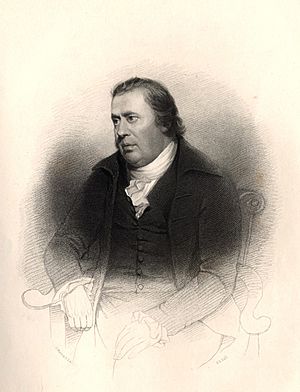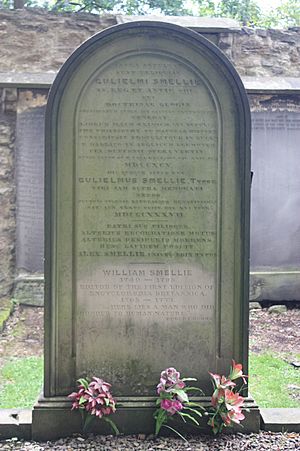William Smellie (encyclopedist) facts for kids
Quick facts for kids
William Smellie
FRSE, FSA Scot
|
|
|---|---|

Smellie, by Henry Bryan Hall
|
|
| Born | 1740 The Pleasance, Edinburgh
|
| Died | 24 June 1795 Edinburgh
|
| Resting place | Greyfriars Kirkyard, Edinburgh |
| Nationality | Scottish |
| Education | Duddingston parish school High School, Edinburgh |
| Alma mater | University of Edinburgh |
| Occupation | Printer, editor, naturalist, antiquary |
| Employer | Apprentice, Hamilton, Balfour & Neil, printers, 1752 Substitute lecturer, botany, University of Edinburgh |
| Known for | Editor of the Encyclopædia Britannica First Edition |
| Spouse(s) | Jean Robertson (m. 1763) |
| Parent(s) | Alexander Smellie, architect, Edinburgh |
| Notes | |
|
Member of the Edinburgh Philosophical Society, thereby becoming a founding fellow of the Royal Society of Edinburgh upon the Philosophical Society receiving its royal charter in 1783
Founder of the Newtonian Club (1760) |
|
William Smellie (1740–1795) was a Scottish printer, editor, and a very curious person. He is most famous for editing the very first edition of the Encyclopædia Britannica, a huge book of knowledge. He was also interested in nature and old things. Smellie helped start important groups like the Royal Society of Edinburgh and was a good friend of the famous poet Robert Burns.
Contents
Early Life and Learning
William Smellie was born in 1740 in The Pleasance, a part of Edinburgh, Scotland. His father, Alexander Smellie, was an architect and builder. William went to school at Duddingston and then at Edinburgh High School.
At just 12 years old, Smellie started working as an apprentice printer. He worked for a company called Hamilton, Balfour & Neill in 1752. He was very good at his job and was promoted to "corrector of the press." This meant he checked texts for mistakes before they were printed. He even won an award for printing a Latin book very accurately.
After his apprenticeship, he joined another printing firm. He spent three hours every evening studying at the University of Edinburgh. In 1760, he started a club called the Newtonian Club. He also helped create the Royal Society of Edinburgh, a group for scientists and thinkers.
In 1763, William Smellie married Jean Robertson in London. A few years later, in 1765, he won a gold medal for his ideas about how plants reproduce. His ideas were different from those of the famous Swedish botanist Carl Linnaeus.
Creating the First Encyclopædia Britannica
When he was 28, William Smellie was hired by Colin Macfarquhar and Andrew Bell. Their big project was to create the first edition of the Encyclopædia Britannica. This huge encyclopedia was released in 100 weekly parts from 1768 to 1771.
Smellie did an amazing job putting it all together. He admitted that he used ideas from many other writers of his time. These included famous thinkers like Voltaire, Benjamin Franklin, and Samuel Johnson.
Smellie wanted the Britannica to be as helpful as possible. He believed that books should be useful. He wrote that if a book wasn't clearly useful, "neither the books nor their authors have the smallest claim to the approbation of mankind." This means he thought books should always have a clear purpose to help people.
Smellie had strong opinions on many topics. For example, he wrote about "farriery," which is the art of treating horse diseases. He thought that people who practiced it often didn't know enough about horse anatomy or medicine.
Even though he knew a lot, Smellie wasn't an expert on everything. His article on "Woman" was very short, only saying: "the female of man." Despite some missing information and mistakes, people loved the first Britannica. Smellie's clear writing and the easy way to find information made it very popular. Some interesting pictures by Andrew Bell also helped it become a success.
Smellie decided not to work on the second edition of the Britannica. He didn't agree with including articles about people's lives in an encyclopedia that was meant for arts and sciences.
Later Work and Legacy
After the Britannica, Smellie continued his busy career. He edited a weekly newspaper called the Scots Journal. He also owned and edited the Edinburgh Weekly Journal with William Auld. He was also an editor and writer for the Edinburgh Magazine and Review.
In 1769, he printed and edited a book called Domestic Medicine. This book was about how to prevent and cure diseases using simple remedies. He also edited the first official writings of the Society of Antiquaries of Scotland, which came out in 1792.
Smellie also translated a famous book called Histoire Naturelle by the French naturalist Georges-Louis Leclerc, Comte de Buffon. This showed his interest in natural history.
In 1779, Smellie was considered for a professor job at the University of Edinburgh. However, the position went to someone else. In 1781, he became the keeper of the Edinburgh Museum of Natural History.
From 1782, he worked with William Creech as a business partner. Smellie kept publishing many different works. His two-volume book, Philosophy of Natural History, became a textbook at Harvard University in the 1800s. In this book, he wrote about the "struggle for existence," which was an idea similar to what Charles Darwin would later write about.
William Smellie's printing office was located in Edinburgh, and his house was nearby. He passed away in Edinburgh on June 24, 1795. He is buried in Greyfriars Kirkyard.
He was good friends with the famous Scottish poet Robert Burns. Burns' words are even carved on Smellie's tombstone: "Here lies a man who did honour to human nature."
See also


